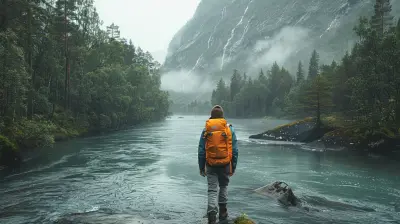Wolves of the Rockies: Tracking the Apex Predators of North America
21 May 2025
The mighty Rocky Mountains stretch across North America, a rugged wilderness where nature thrives in its purest form. But among all the incredible creatures that call these mountains home, none evoke more awe and admiration than the wolves of the Rockies. These apex predators command respect, embodying both raw power and a delicate balance within the ecosystem.
Ever wondered what it's like to track these magnificent animals in the wild? Imagine walking through dense forests, feeling the crisp mountain air, and suddenly spotting a wolf in its natural habitat—spine-tingling, right? This article dives into the world of these incredible creatures, their significance, and how you can experience the thrill of tracking them.
![]()
A Closer Look at the Wolves of the Rockies
Wolves have roamed the Rockies for thousands of years, long before humans ever set foot in these lands. Often misunderstood and unfairly persecuted, these animals play a crucial role in maintaining the balance of the ecosystem.The Rocky Mountain Wolf: A True Survivor
The species found in the Rockies is the Rocky Mountain wolf (Canis lupus occidentalis), a subspecies of the gray wolf. These wolves are built for survival—thick fur coats shield them from harsh winters, strong legs help them traverse steep terrains, and razor-sharp instincts keep them at the top of the food chain.Social but Ferocious: The Wolf Pack Dynamics
Wolves are highly social animals, living in tight-knit packs that function much like a well-oiled machine. Each pack has an alpha pair, the dominant leaders who make crucial decisions for the survival of the group. Then there are the beta wolves, the second-in-command, and the omega wolves, often seen as the peacemakers of the pack.These structured packs rely on teamwork to hunt, care for pups, and defend their territory. Watching a wolf pack function in harmony is like observing nature’s most efficient team at work.
![]()
The Role of Wolves in the Ecosystem
Wolves aren't just predators; they are essential keepers of balance in the Rockies. Without them, the entire ecosystem would spiral out of control.Keeping the Deer & Elk Population in Check
Without wolves, herbivore populations like elk and deer would explode, leading to overgrazing. This, in turn, would exhaust plant life, affecting everything from beavers to birds. Wolves help maintain natural order, ensuring the forests and grasslands continue to thrive.The Ripple Effect of a Top Predator
Ever heard of the trophic cascade effect? This happens when the presence (or absence) of a predator influences the entire ecosystem. A famous example occurred in Yellowstone National Park, where the reintroduction of wolves led to healthier forests, stronger rivers, and even a rise in other wildlife populations.Wolves indirectly shape the environment just by being themselves. Pretty amazing, right?
![]()
Tracking Wolves in the Rockies – An Unforgettable Experience
So, how can you witness these incredible creatures in their natural habitat? Well, tracking wolves in the Rockies isn’t just thrilling—it’s an experience that connects you deeply with nature.Best Places to Track Wolves
If you're serious about seeing wolves in the wild, head to areas where they thrive the most. Some top spots include:- Yellowstone National Park (Wyoming, Montana, Idaho) – The holy grail for wolf watchers. This is where wolves were famously reintroduced in the 1990s and have since flourished.
- Glacier National Park (Montana) – A breathtaking backdrop with a healthy wolf population.
- Banff National Park (Canada) – While spotting wolves here is rare due to their elusive nature, they still roam the backcountry.
The Art of Tracking: Tips and Tricks
Let's be real—you’re not going to just stroll into the forest and have a wolf pose for your camera. These animals are masters of stealth. But with patience, the right knowledge, and a bit of luck, you might just get a glimpse.1. Look for Tracks and Scat
Wolf tracks are distinct—they’re larger than a dog’s, with an elongated shape. Their scat (yes, poop!) can also be an indicator of their presence, often filled with fur and bone remnants from their prey.2. Listen Carefully
Wolves communicate through howling, which can travel up to 10 miles. If you hear a distant, eerie howl, you might be closer than you think.3. Go at the Right Time
Dawn and dusk are prime hours, as wolves are most active during these times. Winter also makes tracking easier since footprints in the snow are clear indicators of recent movement.4. Hire a Wolf Tracker
Wildlife tour companies in Yellowstone and other areas offer guided wolf-tracking tours led by experts who know exactly where to look. This improves your chances of spotting one!![]()
The Challenges Wolves Face
Despite their critical role in the ecosystem, wolves in the Rockies face numerous challenges.Human-Wildlife Conflicts
Livestock owners have historically seen wolves as threats, leading to conflicts that often end in hunting or culling. While solutions like non-lethal deterrents are being implemented, tensions continue.Loss of Habitat
As human development spreads, wolves lose crucial territory, pushing them into smaller areas and increasing the likelihood of conflicts.Legal Battles Over Protection
Wolf conservation remains a heated debate, especially when protections are lifted, allowing hunting. Advocates continue to fight for policies that ensure their survival.Why Wolves Deserve Our Respect
Wolves have been part of North America’s identity long before we arrived. They symbolize wilderness, resilience, and the beauty of raw nature.Rather than fearing them, we should appreciate and protect these incredible creatures. Every howl in the Rockies is a reminder that nature is alive, thriving, and beautifully untamed.
Final Thoughts
Tracking wolves in the Rockies is more than just an adventure—it’s a doorway to understanding one of nature’s most misunderstood animals. Whether you glimpse a lone wolf in the distance or hear an entire pack howling under the stars, it’s an experience that sticks with you for a lifetime.So, are you ready to take this unforgettable journey into the wild? Just remember—wolves see, hear, and sense you long before you notice them. And if you’re lucky enough to cross paths with one, consider it a privilege to witness nature’s apex predator in its true element.
all images in this post were generated using AI tools
Category:
Wildlife EncountersAuthor:

Ian Powell
Discussion
rate this article
3 comments
Caleb Dodson
Forget about trying to see the sights; I just want to witness a wolf in its natural habitat! Just imagine: me, whispering sweet nothings to a furry apex predator. Think they'll let me join their pack? Asking for a friend (who’s really just me in a wolf costume). 🐺😂
June 16, 2025 at 3:31 AM

Ian Powell
That sounds like an unforgettable experience! Just remember, wolves are wild animals—best to admire them from a safe distance! 🐺✨
Nancy McClary
This article beautifully captures the essence of the majestic wolves in the Rockies. The detailed insights on their behavior and habitat provide valuable context for wildlife enthusiasts. It’s a reminder of the critical role these apex predators play in maintaining ecosystem balance. A must-read for nature lovers and adventurers alike!
June 2, 2025 at 3:03 AM

Ian Powell
Thank you for your kind words! I'm glad you found the article informative and engaging. Wolves truly are remarkable creatures that play a vital role in our ecosystem.
Carrie Sweeney
What a fascinating read! Your insights into wolf behavior and conservation are truly enlightening. Thank you!
May 23, 2025 at 4:38 AM

Ian Powell
Thank you so much for your kind words! I'm glad you found the insights on wolves valuable.



